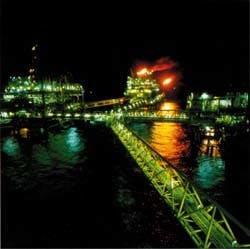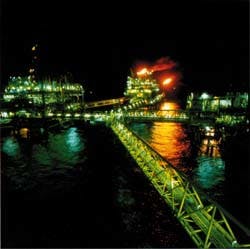Mexico's IMP seeks to lead in oil recovery methods
David Shields
Contributing Editor - Mexico City
Gas flaring in Campeche.
Mexico's Cantarell complex.
The Mexican Petroleum Institute (IPM) is preparing for the future by pushing R&D efforts in secondary and enhanced oil recovery. these efforts are likely to receive a boost with the recent designation of Alfredo Arriola Torres as sub-director of Exploration y Production at the Institute.
"We are currently at work in the laboratory on the latest enhanced oil recovery (EOR) techniques and we are gearing work towards developing the technologies Mexico will require in the future," Arriola told Offshore.
Arriola has been leading work for several years now in characterizing and defining the petrophysical profile of Mexico's major hydrocarbon deposits, including those of the Bay of Campeche, which currently provides Mexico with 75% of its oil output.
"There are several operations involved in analyzing deposits," says Arriola, who is one of the pioneers of secondary and enhanced recovery methods in Mexico and the author of two books and numerous publications on related subjects. (He received his doctorate from the University of Kansas in petroleum engineering.)
"The rock must be characterized to establish its nature, its stratigraphical and geological conditions, whether it is fractured or not, and to identify what kind of hydrocarbon fluids are present. The nucleus of the deposit must also be studied to evaluate its potential productivity. Then, we have to define its dimensions and exactly what kind of trap is actually accumulating the hydrocarbons.
"It is common for wells to produce between 5,000 and 10,000 b/d in Mexico's offshore," he says. Currently, Mexico's offshore fields provide 2 million b/d of crude oil and more than 1.4 bcf/d of natural gas.
Integral studies of deposits
"In the laboratory, we characterize rocks with a scanner to define their porousness, that is, their capacity to store hydrocarbons. The IPM now has a state-of-the-art scanner with nuclear, magnetic resonance."
A sample of rock is taken from four or five km below the seabed for analysis. The deposits in Campeche Bay are from the Mesozoic era, that is, carbonated rocks of the Jurassic and Cretaceous ages.
"We are a pretty big group involved in this at the IPM, about 62 in all, counting geologists, geophysicists, oil engineers, computer scientists, and other specialists. Our main job has been to carry out integral studies of hydrocarbon deposits. In making these studies, we must also use other physical information, such as registers, pressure tests, and production tests, so as to make a numerical simulation of a field's behavior."
Such studies are strategic to administering deposits, as they are the key step required in order to draw up policies for their best possible exploitation, says Arriola. Five multidisciplinary groups are currently involved on this work.
"Our capacity is for five fields at a time, though we plan to characterize about 70 deposits nationwide, both onshore and offshore, for Petroleos Mexicanos (Pemex). Our work implies that we will have to decentralize, in addition to doing some re-engineering work and looking for ways to optimize output and find new reserves."
The IPM multidisciplinary groups have been using the Landmark system for the geological and petrophysical characterization of deposits. This has allowed them to estimate both the volumes of reserves present and the profitability of the deposits.
EOR: a key to the future
Arriola heads the IPM's R&D efforts in secondary and enhanced oil recovery. "We are using miscible gases, carbon dioxide, surfactants, polymers, and thermal processes to improve oil flow. We are searching constantly for the best techniques in oil field engineering that are relevant to Mexico, but, of course, we must always take economic factors into account."
There are about 18 different techniques for EOR using different fluids. The best technique varies from field to field, since it depends on the composition of the rocks, on their petrophysical properties, on whether they are carbonated or not and fractured or not. So, determining the best fluid demands a great deal of work in the laboratory, notes Arriola.
In primary production, our expectations are to recover between 25% and 35% of the oil in each deposit. through secondary techniques, we expect to produce 15% to 25% more. Finally, EOR should give us access to another 20% to 30% of the reserves. But we can only reach this finally stage, if it is economically viable to do so."
R&D work on secondary recovery in the laboratory is geared to finding the best options of exploitation. The scanner allows IPM researchers to reproduce conditions in the field and to try out different gas lift alternatives with carbon dioxide, nitrogen, steam, and other gases.
Water has been injected into some of Mexico's major fields, but it is not always the best alternative, says Arriola, as it does not always provide good results and can damage the structures. Thus, the IMP is now doing pilot tests with EOR techniques.
Another technique often used in Mexico is reinjecting gas into the deposits to maintain field pressure, but the current goal is to use that gas to displace oil by reinjecting it at different pressures and temperatures. Displacement experiments of this type are done in the laboratory.
"I heat up the gas and measure the fluids being produced. I measure the porousness and the permeability in order to characterize the nucleus of the deposit. On knowing the dimensions of the deposit, I can calculate the volume of oil present. Knowing the amount I have recovered and the volume of oil in the deposit, gives me the recovery factor," he explains.
Arriola says that he does not expect much change in oil prices over the coming years, perhaps not for several decades, so a great deal of R&D will have to be done to achieve efficiency in EOR and bring down its cost. This implies reducing the cost of surfactants and of all kinds of techniques being used.
"EOR techniques can push up the price of a bbl of oil as much as $12/bbl, but I cannot afford to wait 20, 30, or 50 years for the crude oil price to reach $35. So I have to look for cheaper surfactants and techniques, for ways of improving recovery factors, and ways of achieving the greatest possible economic benefit."
One of the biggest challenges in exploiting Mexico's oil fields is that they are extremely heterogeneous in nature. They are of highly fractured carbonated rock. "Apart from Mexico, only Russia, Iran, Iraq, Algeria, and perhaps Vietnam have this kind of rock features," he recounts.
"So, we have to work on developing the best technologies, the best production systems, the best tools for their geological and petrophysical characterization, the best techniques in terms of advanced exploitation."
Cooperation efforts at IMP
At this time of global markets and information exchanges, no country can realistically expect to solve its problems on its own. "So, the IPM seeks to share experiences and form strategic R&D alliances with other research centers around the world in order to improve the technologies that are appropriate for Mexico," says Arriola.
One such R&D alliance is the joint participation of Pemex, the IPM, and the French Petroleum Institute (IFP) in the development of the Thrustpack program, a new technological tool for 2D simulation of complex geological structures.
Another area of research in which the IPM is a leader is the numeric modeling of the migration of hydrocarbons. This project lies within the framework of the Fidepemex fund - a fund set up by Pemex to help finance R&D projects at the IPM - and involves cooperation with the IFP and Pemex's exploration and production subsidiary.
The IPM seeks to gain a leading position, too, in geochemistry, especially in mass spectrometry, in which it has top level infrastructure and personnel, comparatively similar to those of Cenpes-Petrobras and the IFP. In frontier areas, particularly deepwater, the IPM's experience in geochemistry should be able to open up new areas of exploration with much more accurate predictions of the origin and the types of hydrocarbons to be found.
In areas of geophysics geared towards oil exploration, the IPM has developed a procedure to lessen multiple reflexions in seismic offshore sections. This has been applied successfully in 3D seismic imaging of the Uech-Kokay Field, data from which is currently being used in characterizing the field. The IPM is also preparing researchers for handling advanced seismic data processing.
Copyright 1996 Offshore. All Rights Reserved.


